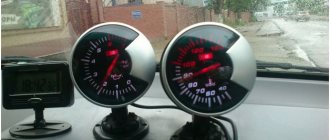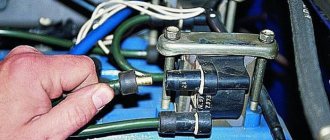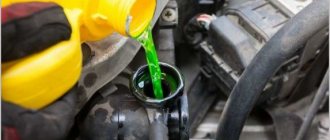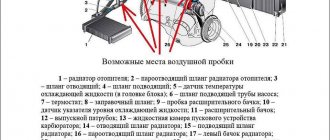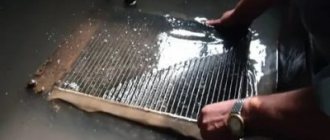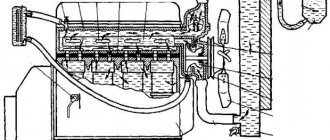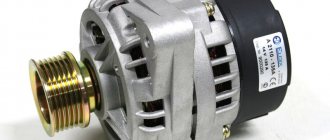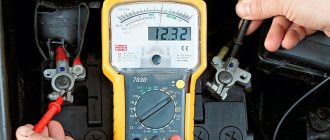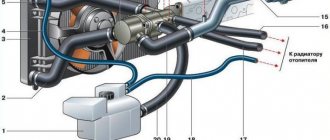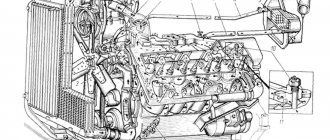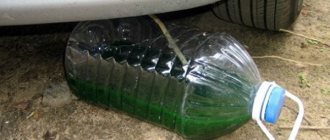During operation, the internal combustion engine heats up to a high temperature. The engine cooling system must cope with the heat removal function. This is necessary for the efficient operation of the power unit. If there is no coolant circulation, the internal combustion engine will very quickly overheat with all the ensuing consequences. Let's talk about what the pressure in the cooling system should be and how to fix typical problems on your own.
Briefly about the main thing
The first step is to decide why there is pressure in the cooling system. It would seem that the banal circulation of coolant should be enough to remove heat. This used to happen when water was poured into the radiator. But it was also common to come across a car on the side of the road with steam pouring out from under the hood. This happened because the water did not have time to cool, and since its boiling point is 100 degrees, it boiled very quickly.
Modern antifreezes, most of which are alcohol-based, boil at approximately 115 degrees Celsius. But it’s worth remembering the school physics course, where you can learn that an increase in pressure leads to a shift in the boiling point of the liquid. This also applies to antifreeze that circulates through internal combustion engine systems.
Normal parameters
It is difficult to say unambiguously what pressure should be in the cooling system of each car. Even on the same model with different installed internal combustion engines, the parameters may differ.
If we talk about average values, then this range is from 1.2 to 2 atmospheres. Although it is extremely rare that the indicators reach 2 atmospheres. But in the automotive industry there is an example when a pressure of 2.2 is considered the norm.
When calculating fluid pressure, the unit of measurement is usually Bars. But they are analogous to atmospheres. That is, 1 atm = 1 bar.
The internal pressure in an automobile cooling system depends on a number of factors. And not the least important role is played by what kind of coolant is poured into the radiator, what design the car’s engine has, its tightness and other nuances.
You can find out accurate information regarding the pressure level specifically in your engine from the manual and operating recommendations from the car manufacturer.
What pressure in the engine cooling system is considered normal?
Much depends on the design features of the car. But usually it is 1.2-1.4 atm. for passenger cars. For example, on a VAZ-2110, 1.2 atmospheres can be considered normal. Critical pressure in the system is achieved when the antifreeze heats up and reaches its boiling point. At this time, the pressure in the system should be released. This is done so that the radiator or any other weakest point does not tear.
The expansion tank cap is responsible for releasing pressure. Its device is extremely simple. There is a metal case with two holes. Inside there is a ball with a diameter larger than the holes. When it reaches a certain temperature it rises. This results in air being vented into the atmosphere. On many cars 1.5 atm. is the pressure at which the release occurs.
So what is the pressure inside the system?
Well, as they say, “let’s show the cards,” but I want to say right away that it is different, and there is no common denominator:
The pressure inside the cooling system varies from 1.2 to 2 atmospheres (rarely up to 2.2), or, as is commonly considered with liquid, from 1.2 to 2 bar.
But why such a run up? It all depends on the structure of the engine, the liquid that is added to it, the temperature at which it operates (after all, it is also different, sometimes 90, sometimes 110 - 120 degrees, especially injection versions).
Such indicators are created mainly by the liquid itself, when it expands (heats). But it is worth noting that the valve cover removes excess indicators.
Valve performance check
Until the antifreeze heats up, the ball inside the lid closes the bottom hole, while the top one remains open. This is necessary for the flow of air from the atmosphere and rapid heating of the coolant. I would like to note that it is periodically necessary to check the functionality of the lid. After all, it often happens that it gets wedged in one of the positions. Because of this, the engine either takes a long time to warm up or does not hold pressure.
Checking the cap of the expansion tank of the VAZ-2110 is extremely simple. To do this, just unscrew it and shake it. If you can hear the ball dangling inside the housing, then the system is working and it is not jammed. Excessive pressure in the engine cooling system, as noted above, can lead to fatal consequences. Therefore, on modern cars the cover has two valves: inlet and outlet. Nowadays you can find lids on sale that operate at a certain pressure. But it is strongly recommended not to change the parameters set by the manufacturer.
Design of the VAZ 2110, VAZ 2112 engine cooling system
| The engine cooling system (ECS) of the VAZ tenth family is liquid, closed type, with forced circulation. Dozens of different motors have their own characteristics and differences. In the article: SOD schemes, the purpose of system elements and their operating parameters. |
Diagram of the VAZ 2110 engine cooling system (carburetor)
1 – heater radiator; 2 – steam removal hose of the heater radiator; 3 – outlet hose; 4 – supply hose; 5 – coolant temperature sensor (in the block head); 6 – pump supply pipe hose; 7 – thermostat; 8 – filling hose; 9 – expansion tank plug; 10 – coolant level indicator sensor; 11 – expansion tank; 12 – exhaust pipe; 13 – liquid chamber of the carburetor starting device; 14 – radiator outlet hose; 15 – radiator supply hose; 16 – radiator steam outlet hose; 17 – left radiator tank; 18 – sensor for turning on the electric fan; 19 – fan electric motor; 20 – electric fan impeller; 21 – right radiator tank; 22 – drain plug; 23 – electric fan casing; 24 – timing belt; 25 – coolant pump impeller; 26 – supply pipe of the coolant pump; 27 – supply hose to the liquid chamber of the carburetor starting device 28 – discharge hose.
High blood pressure and methods of control
The cooling system is designed in such a way that the expansion tank cap is responsible for the pressure in it. Although there are various design options. For example, on some American cars, the expansion tank serves as a sump, and the cap itself is installed on the radiator tee. However, the essence of the work remains the same.
The pressure in the VAZ-2110 engine cooling system should be in the range from 1.2 to 1.5 atm, while a drop or exceeding of these values can already be considered a serious deviation. Quite often, motorists are faced with high blood pressure. The reason will be the same lid, the valve of which is stuck in the closed position. In this case, the system will warm up, the pressure will increase, but it will not be released. Because of this, steam-air plugs form, preventing the normal circulation of coolant through the system.
Causes of high and low pressure in the cooling system
Why is the blood pressure high?
Excessive pressure in the engine cooling system can occur for only one reason: an inoperative air valve in the radiator cap or expansion tank is stuck closed.
Since there is no other way to remove excess air, the serviceability of the valve must be checked periodically. Theoretically, this part cannot be repaired and if it fails, it is usually replaced along with the cover. Experts recommend replacing the radiator cap every two years to avoid sudden breakdowns.
As garage experience shows, carburetor cleaning fluid does a good job of removing deposits that form in the valve and can bring it back to life.
Why is there no pressure
When there is no pressure in the cooling system, this indicates that it is not sealed, and the cause may be more difficult to determine.
- First of all, you should again check the serviceability of the air valve.
- If it is working properly, it is necessary to examine the engine cooling system for leaks (their presence is indicated by a constantly decreasing level of antifreeze).
Replacing a failed unit
The cooling system cap can last longer than the car engine, or you can buy a new one, which will be defective. It's hard to guess here. But in any case, you should not try to repair it. It costs a penny for most models and is non-repairable. In case of malfunction, it is simply replaced with a new one.
At the same time, it is strongly recommended not to shorten the springs by changing the moment of operation of the cover. After all, many motorists do this, which in most cases does not lead to anything good. Of course, if you have tuned the cooling system and engine, then it is quite possible that you need to achieve more pressure in the system or, conversely, less. In other cases, it is worth buying only the original or a worthy analogue with the same parameters. Remember that high pressure in the engine cooling system can lead to local overheating of the internal combustion engine and failure of certain components.
System leakage
An even more popular problem among motorists is lack of pressure. This may happen due to:
- stuck air valve;
- presence of leaks in the cooling system.
Accordingly, identifying the problem will not be difficult. The first thing you can do is look at the antifreeze level on a cold engine. If it does not change from trip to trip, then there are no leaks in the system. The second step is to replace the air valve with a new one. After this, the pressure should normalize and the antifreeze will not overheat. Very often, increased pressure in the engine cooling system causes it to then drop. This is partly due to the wedging valve. Sometimes it works, sometimes it doesn't. As a result, pressure builds up, which can cause a leak to form in a weak spot, and then the seal disappears.
How to find a leak?
The first place to start is with a visual inspection. If you look under the car, it is likely that there is a puddle of antifreeze underneath. But even here you need to understand that often a gap appears only when a certain pressure is reached, so it will not be possible to find it when it is cold. However, there are special devices for pressurizing the system, and the engine must be cold to avoid burns.
As such a device, you can use a conventional pump and pressure gauge. Everything can be done in a garage. First of all, disconnect the upper pipe connecting to the expansion tank. It is advisable to insert a bolt of suitable diameter into the hole. Next, we connect a pump with a pressure gauge to the pipe and build up pressure. When reaching 1.5 atm. the air valve should operate. At the same time we are looking for a leak.
Nuances of the cooling system
Much also depends on the coolant used. For example, there is no need to pour water even into old cars; it is better to buy inexpensive antifreeze, there will be fewer problems. However, modern engines require high-quality cooling. The manufacturer indicates in the manual the recommended brands of coolant. It is advisable to follow these tips and not dilute the antifreeze if you do not have a concentrate.
Modern coolants have different service life and boiling points. For example, G12 boils later than G11, and G12++ has an increased resource, but it is also more expensive. In any case, to avoid engine boiling, it is recommended to fill only high-quality coolant.
Original spare parts
Very often, high pressure in the engine cooling system is formed due to a malfunction of the air valve, we have already dealt with this. Another thing is that this valve has an insufficient resource, or even a new one may not work. This also applies to other elements of the cooling system, such as a thermostat, water pump, pipes, sensors, radiators, etc. To sleep peacefully, it is better to get the original, the service life of which is often quite long. Of course, such spare parts cost several times more, but they almost 100% guarantee the proper operation of the unit as a whole. After all, the failure of such a seemingly insignificant element as a cover can lead to a major overhaul of the engine.
As for Chinese components, this is a lottery. Some of them can be quite high quality, while others do not travel even 100 kilometers. It’s better not to take risks, because the stingy pays twice.
What should the pressure be?
Depending on the make of the car, the pressure in the system will vary. The average value of this parameter is 1.2-2 atm. In the cooling system, it changes depending on the following reasons:
- Coolant used;
- Engine designs;
- Tightness of the system.
An excessive increase in pressure can damage individual components of the system. As a rule, a violation can be identified by the following signs:
- Interior heater rupture;
- The pipe is broken from the mounting.
If during the operation of the car these violations occur periodically, then most likely the safety valve is faulty. This problem can be resolved by replacing the cap on the radiator or expansion tank.
Why is it important to maintain pressure?
Maintaining pressure in the cooling system is important for several reasons. Firstly, the presence of excess pressure contributes to damage to the system components involved in its operation. High pressure can lead to rupture and deformation of many of them, and this will cost the motorist quite a tidy sum. In addition to the consequences already mentioned above, a loss of pressure in the system can lead to failure of the following parts:
- Rubber hoses;
- Thermostat;
- Pumps;
- Metal tubes leading to the radiator.
Sometimes increased pressure in the system leads to malfunctions of the radiator itself.
Watch a video about pressure in the cooling system:
Published: February 09, 2021
Serious consequences
We have already discussed that pressure is created in the engine cooling system. It's quite normal. Another thing is that very often there is a malfunction that is extremely difficult to determine. For example, the antifreeze goes away, but there is no visible leak. In this case, it is quite possible for coolant to enter the engine crankcase. It is recommended to check the oil level regularly. If the coolant actually goes into the engine, the level will increase. Most likely, this indicates a broken cylinder head gasket, changing which is tantamount to rebuilding the power unit.
Any part has its own specific resource, upon reaching which there is no guarantee that it will continue to work properly. There are often cases when even a new expansion tank cap turns out to be inoperative. And now we are not talking about Chinese spare parts, but about original ones. Unfortunately, there is no escape from this.
How does the system work?
It is important to understand that no pressure is created on purpose in the engine cooling system. This indicator does not affect the power units of cars. For the motor itself, it is imperative that all its components are sufficiently cooled. Like any other liquid, antifreeze or antifreeze expands when exposed to high temperatures. On average, the expansion rate of the coolant is 10-20%. In other words, when circulating in the system, the liquid level increases by this amount and pressure arises. The liquid, located in a closed, sealed circuit, presses on the walls of the radiators, pipes and other elements inside the system. Excess pressure in the cooling system is relieved using the expansion tank cap. It, in turn, can, if necessary, suck air from the atmosphere into the system.
Let's sum it up
So we figured out why there is pressure in the engine cooling system, why it can be excessively high or, conversely, low. There is often nothing complicated about checking it yourself, although a lot depends on the car. For example, it happens that the coolant temperature sensor fails. It can provide incorrect data to control devices, thereby misleading the driver. It can show both a high temperature of the power unit and, conversely, a low one. But this will not mean that the system is not working correctly.
If there are any breakdowns in the cooling system, they must be repaired as soon as possible. It is advisable not to operate a vehicle with a stuck cover or thermostat. After all, for some engines overheating is fatal, and major repairs are not cheap at all. In general, it is worth regularly checking the coolant level in the system to ensure that there are no leaks or other defects. It is also recommended to periodically clean the radiators from dirt, as this can cause increased engine temperature.
Car engine cooling system repair
The engine cooling system (ECS) plays an important role in vehicle operation. If it is not working correctly, then it may be that the engine is not warming up to operating temperature. Then the stove does not heat well and the life of the internal combustion engine is reduced. Either the engine overheats, then the car will “boil”. How to determine a malfunction of the engine cooling system with your own hands? I think there is no need to say that the SOD is intended to cool engine parts that are heated as a result of its operation. To identify problems with the engine cooling system yourself, you need to understand how this system works:
Operating principle of the engine cooling system
Cars of the tenth family, like most others, have a liquid cooling system (closed type). This means that heat is removed from the heated parts of the engine by a flow of liquid, which is called “coolant” (antifreeze or antifreeze). The SOD contains:
- Engine cooling radiator, which is designed to cool heated coolant with air flow.
- A radiator fan that increases the cooling intensity of the coolant in the radiator.
- The heater radiator, which is the source of heat for the car interior.
- An expansion tank, which serves to compensate for changes in the volume of coolant due to temperature. You won't be able to add antifreeze without it either.
- A pump or centrifugal pump that circulates coolant in the system.
- A thermostat, which is designed to regulate the amount of coolant passing through the radiator, thereby ensuring optimal temperature conditions in the system.
- The coolant temperature sensor is one of the cooling system control elements.
The operation of the cooling system is ensured by the engine management system, which takes into account various parameters (coolant temperature, oil temperature, outside temperature, etc.). It sets the optimal switching conditions and operating time of the structural elements. The coolant in the SOD circulates constantly, that is, it has forced circulation, which is provided by the pump. Depending on the temperature, the liquid circulates in a small or large circle. To speed up engine warm-up, the coolant moves in a small circle, bypassing the radiator. The thermostat is closed. When the coolant (coolant) heats up to a certain temperature, the thermostat opens and the coolant begins to circulate in a large circle (through the radiator). In the radiator, the coolant is cooled by a counter flow of air, or by an air flow from a fan, which turns on when the coolant reaches a certain temperature. After cooling, the liquid again enters the small circle and so the cycle of movement of the coolant is repeated many times, maintaining the operating temperature of the engine (98-103°C).
Diagnose the engine cooling system and identify problems
If you find problems that are associated with the engine cooling system, then it is better to determine the reasons from simple to more complex: First of all, you need to check the coolant level in the system. In cars of the tenth family, this is done either visually (the expansion tank must be half full) or using the coolant level indicator (installation instructions). If there is an antifreeze leak, then inspect the engine compartment for smudges. Usually the causes of antifreeze leakage are: old clamps on the pipes, a broken engine cooling radiator (radiator repair) or an old heater radiator (heater radiator replacement).
xn--2111-43da1a8c.xn--p1ai
